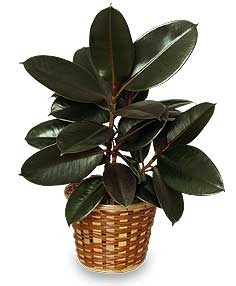
Rubber Plant (Ficus elastica)
Rubber Plant Basic Plant Care:
Rubber Plant (Ficus elastica) is among the most common Ficus plants used as houseplants. Rubber plant care is a task that requires moderate attention. Rubber Plant requires a very moist but well-drained environment, a good balance of light and shade, and a varying fertilizer regimen over the course of its life.
Rubber Plant Houseplant Care: Light Requirements:
Rubber Plant thrives in areas with full sun to partial shade. Take care not to house plants in rooms that receive direct sunlight the entire day. A good measure for the proper brilliance of a room is to keep the plant in a room where one’s shadow can be easily seen on the wall behind the plant throughout the course of the day.
Leaf loss is a very common occurrence in Rubber Plant kept in areas that are too dark or too drafty. When growing Rubber Plant indoors, avoid drafty areas near large windows, air vents, and opening doors. When outdoors, avoid cool and shady areas that receive little full sun. If leaf drop occurs, discontinue fertilization until the leaf drop stops and move the plant into a warmer, more well lit area.
Rubber Plant Houseplant Care: Water Requirements:
Rubber Plant (Ficus elastica) requires a very humid, moist environment. Spray Rubber Plants regularly especially if the plant is surrounded by heated air. During the growing season, water moderately with lukewarm water. Let cold tap water to stand until room temperature as this allows chlorine to evaporate and reduces the shock that cold water can cause to plant roots. Reduce watering during the winter, keeping the soil moist but careful not to over water as plants require less water during their natural resting season.
Yellow leaves are a typical indication of excessive watering. A common misconception among those who nurture Rubber Plants is that yellow leaves are a sign of too little watering. If leaves begin to yellow, wilt, or fall, cease watering and fertilization until the soil becomes properly moist again and the problems discontinue.
Rubber Plant Houseplant Care: Fertilizer Requirements:
For the young roots of Rubber Plant, apply a high phosphorus fertilizer to stimulate root development. As the plant matures to producing much foliage, apply a high nitrogen fertilizer every four (4) weeks during growth as this stimulates full and healthy foliage development.
Rubber Plant Houseplant Care: Pests & Diseases:
Rubber Plant is susceptible to many common pests such as mealybugs, scale insects, spider mites, root knot nematodes and thrips. Pathogen (fungal and bacterial) problems may also occur in the form of leaf spots, crown gall, twig dieback and Southern Blight.
Rubber Plant Houseplant Care: Propagation & Potting:
Rubber Plant needs to be periodically transplanted into larger pots. Failing to transplants pots as growth occurs can cause root damage that will stunt the growth of the plants. Some binding is necessary for stability and maintaining a tight root ball for later transplanting. For this reason, transplant Rubber Plant into pots that are no more than one (1) inch larger in diameter each time. Be sure to use fresh soil for each new potting.
Root semi-ripe cuttings or leaf-bud cuttings in spring or summer using bottom heat. Seed should be sown in the spring at 59-70oF. Rubber plants can also be air layered in the spring or late summer.
Rubber Plant Houseplant Care: Pruning
Rubber plants (Ficus elastica) do not require much pruning. Mulch annually and remove dead and/or dying leaves.


 Find Your
Find Your 
